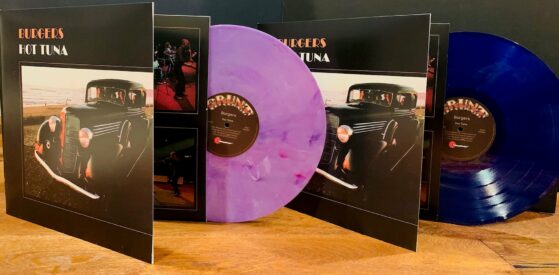

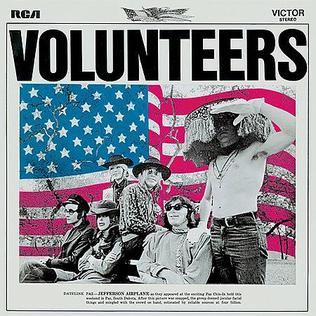
Jefferson Airplane revisits its final flight
Read the story on Relix.
In celebration of Volunteers’ 50th anniversary, Grace Slick, Jorma Kaukonen and Jack Casady revisit their band’s final flight.
REBELLIOUS PATRIOTS
Jorma Kaukonen: Looking back on the emotional and political landscape around Volunteers, Jack and I were more interested in the musical aspect than being politically involved in the way Paul [Kantner], Marty [Balin] and Grace were. That being said, if you were a San Francisco musician in that time period, it was impossible not to be involved on some level. We just didn’t verbalize it. Volunteers also coincided with all this upheaval in our personal lives. My ex-wife Margareta, Grace, Spencer Dryden—who was Grace’s significant other at that time—and I shared a duplex apartment and it burned down. So I wound up living in the big Airplane house until we found a new place. Looking back from the lofty peak we all inhabit today, Volunteers was a pinnacle for the band—there’s some classic Paul and Grace stuff on that album. There was still so much passion and involvement by the band members, which I think dovetailed with what was going on culturally. After that, Spencer left and that was the end of the “classic” lineup.
Grace Slick: The title Volunteers is not quite as in depth or as important as you might think. Marty, who was the founder of Jefferson Airplane, happened to see a truck go by that said “Volunteers of America” on it. It’s an outfit that helps underprivileged people. He liked the title, so he just used it. [Laughs.] None of us were sure what it meant—we used to just grab things out of the air. I suppose you could turn it around and say that we were rebellious patriots. And lately, I’ve been even more rebellious. When Donald Trump got elected, it made me cry—and I don’t cry. I thought, “If the founding fathers could see what’s going on right now, they’d be stunned.” The President of the United States is a clown. People have joked, “Even you Democrats would pray for Bush.” [Laughs.] It’s even more repulsive now than it was then. I just hope that I live long enough to see another president, like [Elizabeth] Warren, get in there—a regular human being. It’s hard for it to get worse than it is right now. We had Nixon to contend with, but he was a much better president than Trump—unbelievable.
DOSING EDICT
GS: I was invited to [the White House during Nixon’s presidency]. I went to the same college—and I use that word loosely because it was really a finishing school where they taught you how to get a Princeton or Yale boy—as Tricia Nixon. Since it was so small, she sent invitations to all the alumni to come for tea at the White House. Because it was addressed to my maiden name, they just thought I was some broad who went there. I brought Abbie Hoffman, who was one of the Chicago Seven, with me and, as we were in line to go into the White House, security came up to me and said, “I’m sorry, you can’t go in because you’re a security risk.” I said, “No, I’m not. I’m a rockand-roll singer!” They didn’t even talk to Abbie, even though he was standing right there and on the FBI’s most wanted list!
It’s good that they didn’t [let me in] because I had about 600 mics of LSD in my pocket. I knew how to do “formalities” because of finishing school. I had a very long, little pinky fingernail and, as I was talking to Richard, I was gonna reach into my pocket, get some LSD under my nail and then gesture over his teacup. We got a big chuckle out of the fact that he would be wandering around the White House, talking about the walls melting. But they wouldn’t let me in, so I didn’t get a chance to do that. It’s probably for the best—it’s rude to dose people with acid unless they’ve had it before. We used to dose each other—if you left a Coca-Cola can open at one of our concerts, where the Dead or Quicksilver and Janice were, you were gonna get dosed.
NOT A MULTITASKER
Jack Casady: Before Volunteers, we recorded all of our albums in Los Angeles. That’s where you went back in the day. Eventually, Wally Heider put together a new San Francisco studio just so bands didn’t have to slog it out in LA, and we were the first group to record there. That was really the beginning of that San Francisco-era of recording.
GS: San Francisco’s small, and our community of rock-androllers was about 15 bands. Jerry Garcia or David Freiberg would come over and put something on a song and we’d go over there and play on their stuff because it was a loose and friendly community. Our first album came easily because we played all the songs live, over and over again. But the consecutive albums took a long time, and it was very expensive for RCA, who was paying for our time.
We did interact with some of the LA bands—Crosby, Stills & Nash and The Mamas and the Papas. Paul knew Crosby and Stephen from being an acoustic folk singer. One song we did with Crosby was “Triad,” which was frowned on by a lot of people because it’s talking about three people making love at the same time—even his group wouldn’t let him record it. He brought it to me and I said, “Sure, I’ll do that.” I don’t do triads, not because I object to them morally, but because I’m not a multitasker, so doing two people at once would be confusing for me. I wouldn’t like it because there’s too much going on. “Whose leg is this? Whose arm? Is that my left ear?”
SOMEBODY DIFFERENT EVERYDAY
JC: After Surrealistic Pillow, we were able to renegotiate our label contract and take control in the studio. It was a very fertile and exciting time because, usually, the studio was a very nerve-wracking experience. We were able to experiment more—sometimes with great results and sometimes with not as great results. All the guys were doing it—Jimi Hendrix was doing it on his Ladyland album, which I was a part of, and the Grateful Dead started experimenting in the studio.
JK: There was a lot of improv that happened in our live sets. Look at the canvas that Jack, Spencer and myself had a chance to paint on. We had some of the great writers of the American songbook. Paul, Grace and Marty wrote such idiosyncratic stuff, especially Paul and Grace. People occasionally ask me: “Why don’t you solo like you did with the Airplane anymore?” The answer is that we don’t play those kinds of songs anymore. In a live context, our singers allowed us to do that.
In a more traditional, successful rock-and-roll venture, the singer would always be the most important thing, and the side band would get fired if they screwed around. But we were encouraged to screw around. One of the things that I told Grace the last time I had dinner with her was, “I’m really sorry that we played so loud while you sang. If I had to do it over again, the dynamics would have been better.” But it was a real team effort. We supported our great singers as best we could. When the time came to take off, they just said, “fly.” And nobody played the guitar like Paul. He rarely gets the credit that he deserves for the sound of the Airplane. He wasn’t a typical rock-and-roll rhythm guitar player. The mixture of him, Spencer and Jack, in my opinion, defined what became the Airplane’s sound.
GS: Sometimes we’d play for four or five hours. Jorma, Paul, Jack or somebody would yell out “D minor!” and just jam. And Marty or I would make up lyrics. Now, the rappers like Eminem and Dr. Dre do it better than we did—the first time I understood that was when I saw the movie 8 Mile. But mostly, it’d just be instrumental [jams]. Now, it’s more organized as far as who goes on when, what they wear. We didn’t have any exploding chickens or dancers back then—they were lucky that we just showed up with our clothes on. I never wore tie-dye because I didn’t like it, but we wore actual costumes in the ‘60s—sometimes I’d dress as a pirate all day and just go to the grocery store like that. It was great sport to just be somebody different every day—a boy, a girl. I was never an animal because those outfits are too hot, but I was every human you could think of. Though, these days, I’m mostly dressing as a sweatshirt-and-sweatpants human being. [Laughs.]
Read more on Relix.

Jorma Kaukonen to host “Ask Me Anything” Session on Reddit
Legendary guitarist Jorma Kaukonen, of Jefferson Airplane and Hot Tuna fame, will host a Reddit Ask Me Anything on r/gratefuldead. The session will occur on Dec. 20 at 7 p.m. ET.
Of course, Kaukonen has a storied music career, including collaborations with the late Robert Hunter, such as Hunter’s 1984 album Amagamalin Street, released at Relix Records. In addition, Kaukonen contributed some words on Hunter for Relix’ upcoming issue honoring the lyricist; head to relix.com/ripple for more information.
Head to reddit.com/r/gratefuldead on Dec. 20 to participate or read the AMA.
Throwback Post: Jefferson Airplane performs at Wally Heider’s Studio
Read the whole piece at Jambase.
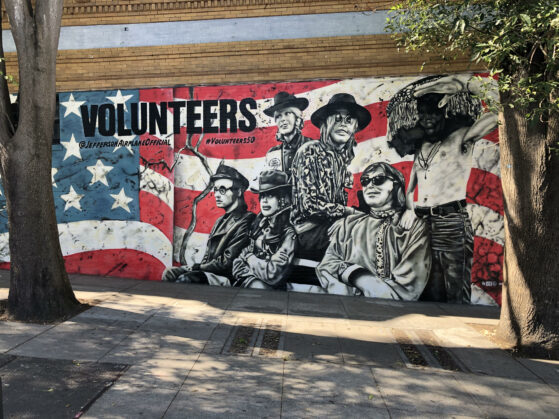
Visit the VOLUNTEERS Mural For Your Chance to WIN a Jefferson Airplane Tee From DayDreamer
“One generation got old, One generation got soul..
This generation got no dissertation to hold, Pick up the cry…”
Volunteers of America – it’s up to us to mobilize and change the world!
Honor a half-century of defying The Establishment by visiting the VOLUNTEERS mural and for your chance to WIN a Jefferson Airplane vintage-inspired Tee from Daydreamer.
How to Enter:
- Take a photo of the mural at Haight and Masonic in San Francisco and repost on your Instagram feed and in your Story⠀
- Tag it #Volunteers50 and @JeffersonAirplaneOfficial
- One lucky winner will be selected on November 1st, 2019
“Got to Revolution!”

New Jefferson Airplane mural honors Volunteers on its 50th anniversary
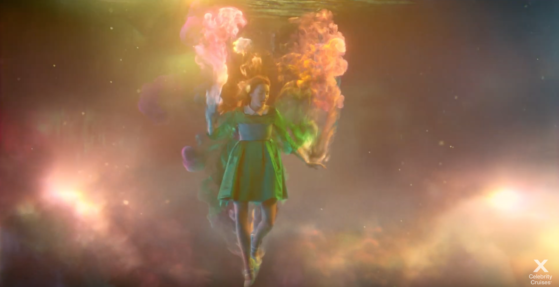
Wonder Awaits: “White Rabbit” delights in new commercial for Celebrity Cruises
Set the psychedelic backdrop of Jefferson Airplane’s ‘White Rabbit’ Celebrity Cruises has unveiled an ethereal TV spot called ‘Wonder Awaits.’
It is the first campaign created by Lucky Generals, after it won the bid for Celebrity in the autumn of last year.
The TV spot follows a female protagonist on a voyage of discovery through a dream-like wonderland – onboard Celebrity Cruises’s newest ship – ‘Celebrity Edge.’
After dozing off on her sun lounger, she plunges gracefully down a psychedelic body of water, before landing on the dining table of one of the cruises. She then embarks on a weird eden-istic journey, that sees her experience all the ships offerings.
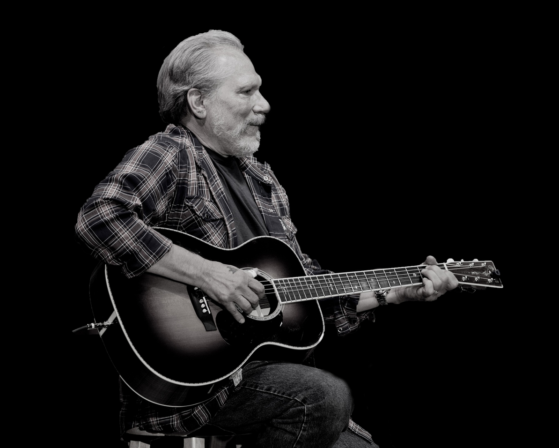
Jorma Kaukonen Reflects on ‘Surrealistic Pillow’ And The Life of a Legendary Band
In 1967, San Francisco rockers Jefferson Airplane released “Surrealistic Pillow,” an album that put the Haight-Ashbury hippie scene on the commercial map and featured the band’s two biggest hits, “Somebody to Love” and “White Rabbit.” An unprecedented and unmatched mix of Peter, Paul and Mary’s harmonious folk-revival music, Howlin’ Wolf’s overdriven guitar blues, Bo Diddley and Chuck Berry’s driving early rock and roll, and melodic pop-rock à la “Revolver”-era John Lennon, “Surrealistic Pillow” offers a spooky and intense vision of psychedelia that stands in striking contrast with the more carefree sounds of other psychedelic music, in its era and since. The Harvard Crimson spoke with Jorma Kaukonen, Jefferson Airplane’s lead guitarist and sometime singer-songwriter, about the making of the album and more.
The Harvard Crimson: Rick Jarrard produced “Surrealistic Pillow.” What did that mean, exactly?
Jorma Kaukonen: Rick really took an active role in how things were evolving in the studio. He had a lot to say. “We need a guitar accent here,” or “we need a solo there,” et cetera. We also had Jerry [Garcia, of the Grateful Dead] on board, and he helped us with arrangements and with band dynamics, because he had so much more familiarity with that stuff, but Rick Jarrard was the producer.
THC: Was there ever tension between Jarrard and the band over his creative input?
JK: We sort of bristled against some stuff, just ‘cause we liked to think we came up with everything ourselves. But at the same time, I think that everybody in the band, even Paul, Grace, and Marty [Kaukonen’s bandmates] recognized that we were in uncharted waters. When you go into the studio and record something, it’s a different ballgame from playing a live show. I don’t think the album would have had the same sonic quality had the members of the Airplane, myself included, been able to drive the bus more. So, did Rick make us do stuff that we probably wouldn’t have done if left on our own? The answer is yes, and after the fact, my personal opinion is that this was a good thing.
THC: What sorts of things did Jarrard push for?
JK: One example is that when he heard me playing “Embryonic Journey” in the lobby to the security guard, just for fun, he said “I want to put that on the record.” And I thought he’d lost his mind, to put a folky fingerpicking piece on a rock and roll record. He recorded that in one take, and all the echo on it is real room echo.
THC: I’ve always assumed that the echo was applied in post-production. Did he put the mic, like, fifteen feet away from you?
JK: The mic was probably pretty close to the guitar. I wish I could say I remember, but I don’t. But that’s something else, too: recording guys like Rick, these guys were masters of mic placement. RCA had two books out in the ‘50s about mic placement, more about recording classical music and orchestras, that are still kind of the Bibles for guys that are interested in that kind of stuff. And those guys, back in the old days, they had that stuff down.
THC: You’ve said that when you first joined Jefferson Airplane, you were asked to play a Rickenbacker twelve-string because Roger McGuinn [lead guitarist and singer of the Byrds] used one. When you were making “Pillow,” did you think about emulating your contemporaries, like “I’ll play a Hendrix-y lick here,” or avoiding sounding like them?
JK: The answer is no. First of all, I don’t think we’d heard Hendrix yet, although he went on to be so influential on so many levels. Second of all, I recognized early on that what McGuinn did with the Byrds was utterly alien. It was really cool, and he’d architected a guitar sound that was completely his own, but I just played like me; I wasn’t able to do what he did. I think Paul would have been happy if I’d been able to do that, but the twelve-string didn’t last long in the Airplane, because that just really wasn’t me.
THC: There’s a polyphonic approach to vocal arranging across the album there that I don’t really hear in any other ‘60s rock music. In the B section of “She Has Funny Cars,” for instance, Marty and Grace have dueling vocal lines, instead of harmonizing lines. Where did that come from? It seems like a classical idea.
JK: That call-and-answer thing, with Grace and Marty, it’s just the chemistry of these two people. Grace had some classical training, and she liked Erik Satie [fin-de-siècle French avant-garde composer] a lot, and I’m guessing that she was probably driving that. I mean, nobody would have told anybody what to do, ‘cause it didn’t work like that, but the vocal harmonies of the Jefferson Airplane were very idiosyncratic. From the beginning to the end of our thing as a band, there’s some really interesting stuff.
THC: Are there any bands around today that you think are doing the kind of work you were trying to do, carrying the torch?
JK: One of the bands that I’m extremely fond of for a number of reasons –– and I don’t think they’re influenced by us on any level, but they carry the same kind of spiritual torch — is [Lake Street Dive. I just love that band; they’re great. And no matter what Rachael Price [Lake Street Dive’s singer] and her pals are going for or how they see themselves, they’re not a typical rock and roll band. They’re not a typical jazz band. In my opinion, they really are their own thing, whatever that thing is. And if nothing else, in the era when the Airplane was young, the Airplane was absolutely its own thing.
—Staff writer Alasdair P. MacKenzie can be reached at alasdair.mackenzie@thecrimson.com.
Source:
https://www.thecrimson.com/article/2019/7/29/jorma-kaukonen-surrealistic-pillow-jefferson-airplanes/